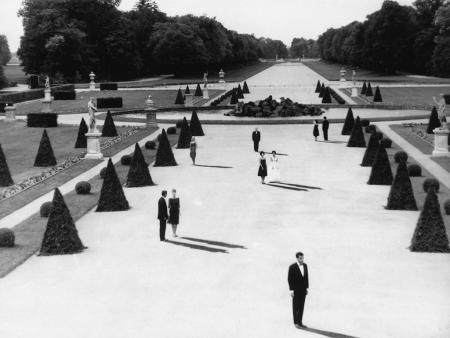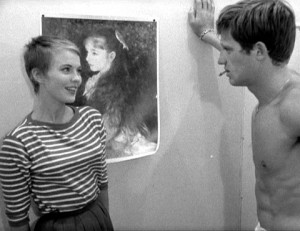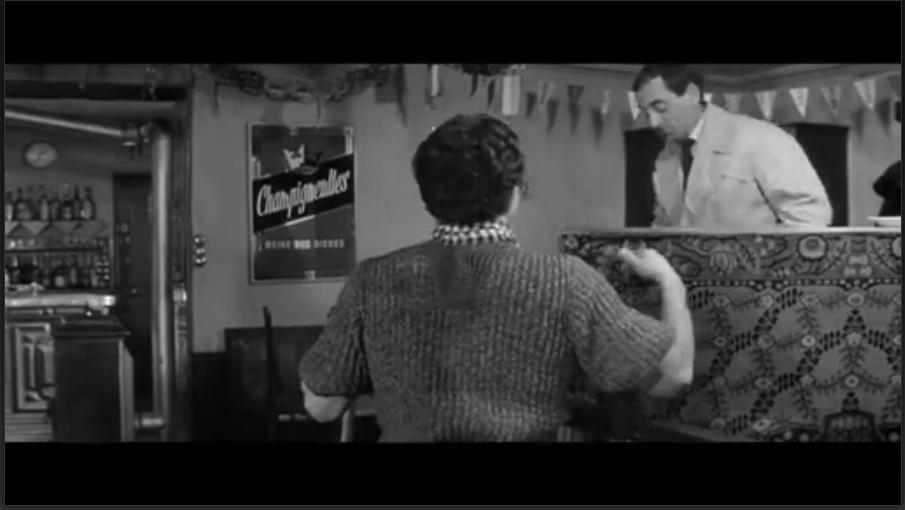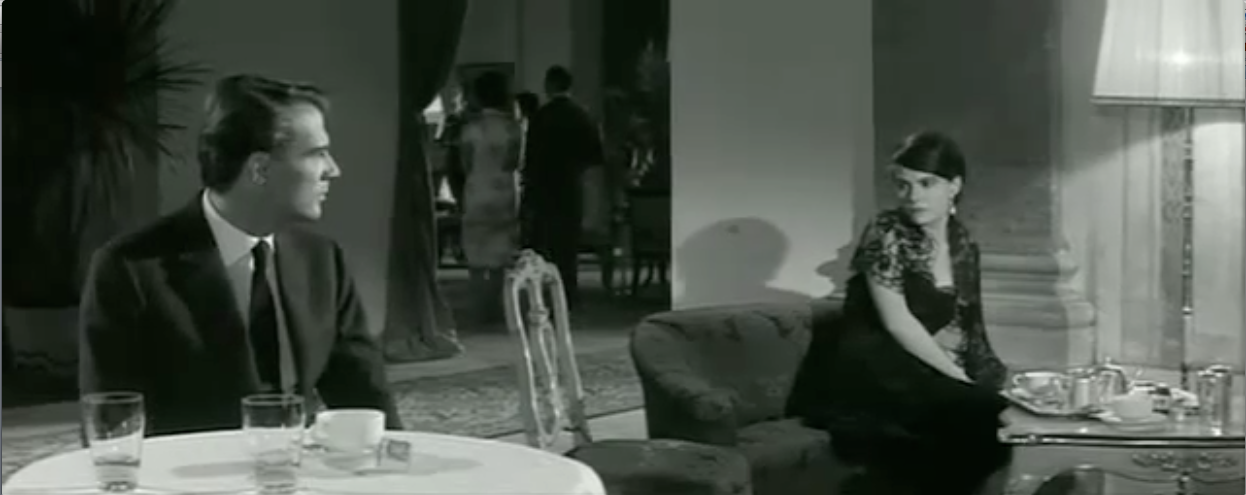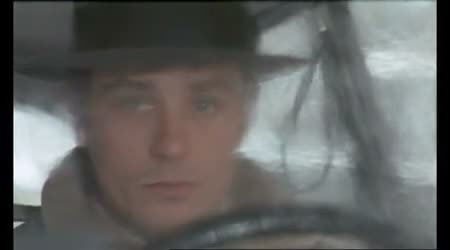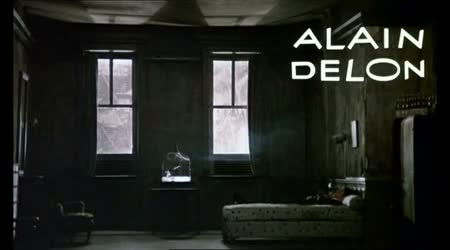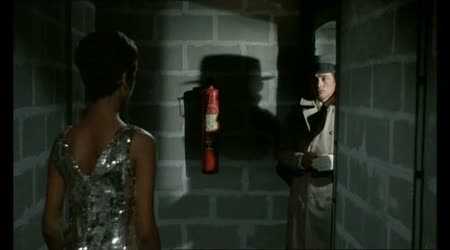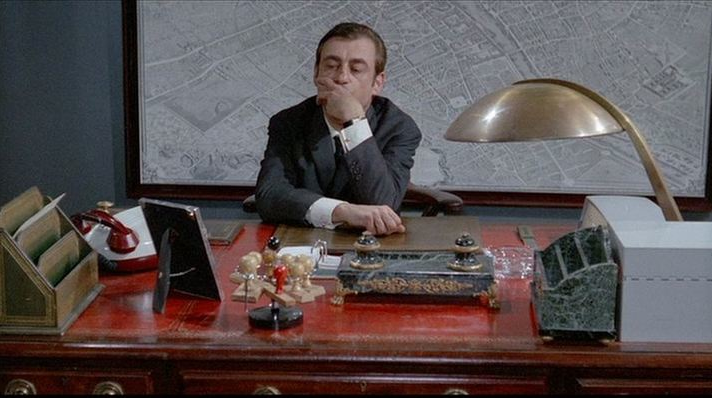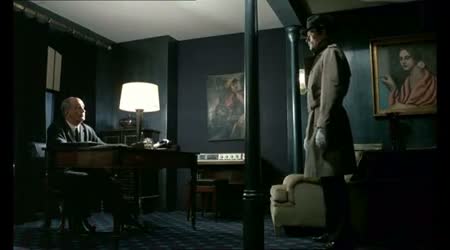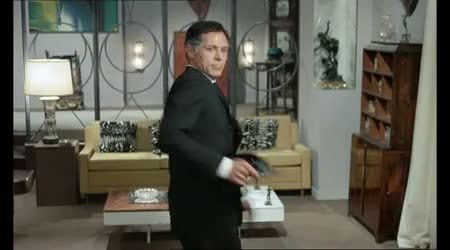“The Most Beautiful Fraud in the World:” A Production Designer Reflects on the War between the French New Wave and Scenic Design
SPRING 2012, ISSUE 2
— Yolande Thame
For me, the height of film production art lies within the built environment, which is imagined, sketched, drafted, modeled, and finally constructed. Whether on a sound stage or developed sitting on an exterior landscape, the physically built facade holds an elevated esteem because it clearly signals a conscious decision to lead (or manipulate) a viewer’s perspective. Film sets constitute a particularly tangible, if temporary, indication of narrative context because they reveal a production designer’s ability to conceive a world from scratch. There is a qualitative distinction between “narrative design,” which visually defines the socioeconomic status of characters, frames the realistically- or fantastically-based time period/location, and sets the aesthetic mood, and “set dressing,” those efforts to “assemble” physical objects, worldly possessions, and contextual details that support story-telling objectives. Narrative design takes a holistic approach to the visual aesthetics of a film and frequently uses set dressing to convey additional background for a screenplay, but effective set dressing seldom occurs without a cohesive narrative design. On its own, set dressing is reduced to a random assemblage of elements, which can leave viewers with vital gaps in character identity or distract the audience with their misplacement. Those types of spectator distractions shift attention away from the story and alert viewers to the artifice of the filmic medium, which is why most production designers prize cinematic work that remains “unconsciously registered background” or “invisible” to the viewing audience.[1]
Narrative design’s aspiration towards imperceptibility or plausible “realism” was overtly challenged by the French New Wave, whose directors typically omit or radically reconceive the traditional art of production design. My intent is to explore here the narrative impact of those decisions and to map how the New Wave influenced the production design profession in general.
Historical Landscape
The French cinematic tradition that preceded the Nouvelle Vague was well versed in how constructed sets interacted with the camera lens, lighting and other elements of mise-en-scène to produce spatial acceptance by film audiences. Using scaled models, painted drops and other depth and perspective tricks, production designers, as early as the 1910s, were already capable of creating seemingly holistic environments that visually disintegrated if shifted from their intended vantage points.[2] By 1930-40s, both European and Hollywood entertainment industries competitively utilized traditional production design methods and the modeled environment represented the status quo. Scenic design techniques, which partially originated from live theatrical performances, spread through Europe by way of the craftsman immigrant populations. These highly skilled architects and artists, displaced from countries like Russia and Germany after the Bolshevik and First World Wars, found acceptance within the progressive entertainment industry despite being shunned by other areas of society. Within the visual realm, these immigrant interpretations of “French” scenic space were a necessary exaggeration of contemporary artistic trends and historical architectural motifs that ultimately aided nationalistic agendas to promote local work over the influx of Hollywood films.[3] The stylistic patriotism was essentially successful because despite both world wars constricting the production and flow of movies in France to nostalgic or propaganda varieties, even American film studios looked across the Atlantic for visual decorative inspiration. As Tim Bergfelder, Sue Harris and Sarah Street assessed in their book, Film Architecture and The Transitional Imagination: Set Design in 1930s European Cinema, these “émigré” scenic artists “deployed design strategies that privileged the exotic, the distant and the historical” and resulted in an aesthetic they termed “poetic realism,” which often created city landscapes and glossy interiors unrecognizable but mesmerizingly engaging to the average French citizen.[4] Soon after, the hyper-stylized visual trends of the 1930s were morphed and repackaged into a “tradition of quality.” This label was cheekily assigned to films produced under government aid-programs, developed to bolster the war-crippled industry, which fostered the use of “approved” craft traditions despite their appropriateness for the story.[5] Although the “tradition of quality” signaled more about the film production infrastructure than a specific scenic aesthetic, it does, however, highlight a preferred artistic mode for movie fabrication. It represented a departure from the “poetic realism” of the 1930s to what Francois Truffaut labeled “psychological realism.”[6] Film scholar John Hess later explained Truffaut’s phrase in this way: “While the films of ‘poetic realism’ were content to assign control to destiny or human weakness as in Le Quai des brumes [Port of Shadows] or Le Jour se lève [Daybreak] (1939), the films of “psychological realism” tended more often to reproach society for human evil and suffering: Autant-Lara’s Douce [Love Story] (1943) and Le Diable au corps [The Devil in the Flesh] (1947), and Clement’s Jeux interdits [Forbidden Games] (1952)…”[7]
Hess was essentially highlighting a perspective shift from “decor and situation” to a fascination with “character.”[8] The Nouvelle Vague, however, represented an attempt to supplant the importance of these formulaic narrative conventions that used studio sets to promote an overly polished environment that audiences grew to accept as distinctly French.
The French New Wave began as a rebellion against the hierarchical studio system, which produced lofty visions that contradicted the realities of contemporary European life. By the 1950s, the studio system contained countless foreign aesthetic filters that rendered the final cinematic products ultimately disconnected from viewing audiences. Immigrant craftsmen moved up the movie production ranks and gained significant artistic influence over film production, which resulted in romanticized visions of French culture. After World War II, many film projects erred on the side of safety by adapting classic novels or historical themes but through lenses aimed at emphasizing “accepted” character behavior rather than strictly adhering to the literary confines of the original works.[9] Even those that dared to broach the subject, painted France’s role in the war in a politically patriotic manner.[10] A general social yearning for honest and relevant movies, not just about the war, but also reflecting contemporary culture, grew over time. Directors like Claude Chabrol, Jacques Demy, Jean-Luc Godard, Louis Malle, Jacques Rivette, Eric Rohmer, and Francois Truffaut were all concerned with more accurately depicting the rambling, rebellious, and arbitrary lives of youthful, post-war characters. The Vague offered a new documentary style of filmmaking using mobile cameras, outdoor shooting, found locations, natural lighting, long meandering takes, brisk editing, novel jump cuts, and improvised story lines. Furthermore, the New Wave emphasized filmmaking as personal expression (auteur cinema), vastly reducing the film crew to key personnel over which directors had tight control. All of these factors relegate the production designer, if hired at all, to a continuity wrangler (editor) rather than a visual gatekeeper (creator).
The Core Cases
Jean-Luc Godard’s À Bout De Souffle (Breathless, 1959) tells a sexually charged story plucked from a 1952 French news headline and follows the lead protagonist, a mischievous young criminal, from Marseilles to Paris, with a false naturalistic style. Godard broke the fourth wall, cut between scenic actions, favored the hand-held camera, used editing to establish erratic pacing, and employed only one art production member, Clément Hurel, who designed the movie posters. For this breakout New Wave film, Jean-Luc Godard planned shoots on a daily basis, many times revealing the scene contents to actors minutes before the camera rolled.[11] Under such conditions, the production’s art department would only have time to assemble key items handled by actors, typically called hero props (stylistically cued from Godard’s personal affinities), and/or randomly react to changing story-lines with whatever was on hand or could be quickly constructed. So visual composition was left, almost exclusively, to the director and his extended eyes, the cinematographer. Visually, the film captures the romantic Parisian streets and presents fresh and stylishly dressed characters that epitomize youthful exuberance. Godard’s use of real spaces creates a dichotomy where audiences glimpse “authentic” French environments but the characters (and story) have no narrative ownership over those locations. The famous eleven-minute bedroom scene takes place in a hotel-like space of bare walls sprinkled with thumbtacked poster replications of noted French paintings (Figure 1). In such a sterile environment, it is difficult to determine the heroine’s (Patricia Franchini) mood, temperament or character backstory. À Bout De Souffle was a directorial pioneer but used existing places (motivated by availability not character development) as the cornerstone of its aesthetic language and therefore cannot really be considered scenically progressive. However, the freedom with which locations were utilized opened the doors for younger directors to experiment with story-telling methods.
Francois Truffaut’s second feature, Tirez sur le pianist (Shoot the Piano Player, 1960) also showed a fresh perspective on novel adaptation practices. Truffaut loosely based the film on David Goodis’s Down There, but modified the lead protagonist to be a timid, awkward and scared gentleman rather than the decisive caricature in the novel. We follow an insecure, ex-piano prodigy, Charlie Kohler, as he attempts to escape his demeaning professional life, save his hapless brothers from pipe-smoking gangsters and regain his faith in romance. The new direction resulted in disjointed actions, arbitrary dialogue and several disarmingly comedic moments. Peter Brunette describes Tirez sur le pianist as a “postmodernist” genre mix of “clashing mood and modes” superimposed over a film noir story.[12] Jacques Mély received credit for the art department, but it was clear that Truffaut used the streets, hotels, bars, and snow-capped countryside of France like a weapon. Truffaut allowed random details to take precedence over the scenes, exemplified when Kohler’s brother slams into a light post mid-car chase. Interiors like Kohler’s pub were littered with posters, paper-mâché streamers and stacked crates that accidentally became a means for escaping thugs at one point in the story (Figure 2). Very little “design” could have taken place in this spontaneous type of filmmaking but there was a trend of contrasting dark and light moods. In the same way that heartfelt and slapstick moments were tightly sandwiched together, so were the rapid transitions between indoors and outdoors, through brightly-lit and murky spaces, around old-world and contemporary furnishings, or within formal and informal interiors. The disjointed mixing of styles, locations and moods challenges continuity editing conventions made popular by Hollywood films. Through its iconoclastic style, Tirez sur le Pianist makes the viewer aware of composition and pacing rules, which historically dictated that scenic elements only transition in response to a character’s emotional arc. It breaks ties with “appropriate” narrative and visual pairings, which seamlessly transition viewers through emotions and deceptively lull them into identifying with the lead protagonists. The film has rightly been praised for its actor direction, narrative jumps, and use of cross-bleeding shots, but like À Bout De Souffle, it marks a notable stripping away of created environments.
The appeal of French New Wave films lies in their fleetingly captured realism and seemingly incidental depictions of characters’ ambiguous and erratic modern lives. As John Hess notes in his analysis of Truffaut’s writings, “the auteur critics were far less interested in the causes of human behavior…than they were in the personal means a character used to transcend his or her environment and to reach some sort of salvation.”[13] Since understanding and then defining an image system to display motivation for human behavior is the primary focus of production designers, the initial split between the two camps was inevitable. The movement was reactionary and paved the way for a fundamental shift in the approach to cinematic production. For a time, directors moved away from character-driven, scenic environments to “real locations,” whose randomness facilitated the audience’s emotional detachment from the story and its characters’ development. These rogue productions, by their very nature, defied spatial ownership and therefore character branding. Actors discovered boundaries on camera and made any narrative progression (or lack there of) entirely dependent on their reactionary performance. The resulting tone made these films liberating for both actors and audiences, but virtually froze narrative scenic progression.
New Wave directors were determined to challenge every convention of the medium; however, fringe supporters used these practices to redefine the context elements for art cinema. Even though the initial intent leaned toward low-fidelity filmmaking, as popularity and supporting budgets for the movement grew, certain directors, like Alain Resnais and Jean-Pierre Melville, began to explore how the built environment could facilitate their story-telling objectives in minimally invasive ways. By embracing their auteur status and streamlining production processes, these directors found ways to balance the progressive ideals of the Nouvelle Vague with the creation of visually compelling narrative environments.
L’Année Derniere à Marienbad (1961)
One example of scenic environments facilitating the progressive deconstruction of story-telling objectives is the surrealist vision, L’Année Derniere à Marienbad (Last Year at Marienbad, 1961), from left-bank director, Alain Resnais. Both Resnais and the film’s screenwriter, Alain Robbe-Grillet, envisioned the film as an architectural plan, where characters were as statically sculptural as inanimate objects.[14] In a Criterion Collection interview about the film, Ginette Vincendeau claimed that L’Année Derniere à Marienbad was a rejection of plot, chronology, “characters,” naturalism, and point-of-view stability.[15] The story was deceptively simple: a man (X) pursues a woman (A) through the vast corridors of a luxury hotel, in full view of another man (M), who may or may not be her husband. It represented the iterative telling of narrative possibilities–fragmented, reordered, and perceptively skewed. The narrative abstruseness inverted classical storytelling techniques and pushed the boundaries of meaning behind moving images.
The piece was filmed within the “authentic” Munich châteaux of Schleissheim, Nymphenburg, and Amalienburg, which were already stunning examples of Baroque architecture, Rococo interior, and Neoclassic landscaping design styles. On the surface, employing environments with such historically recognizable decorative motifs may lead observers to categorize this film alongside French “tradition of quality” features. However, Resnais’s extreme focus on the ostentatious architectural details elevated them to theatrical devices and deemphasized the cinematic practice of leading with character action. The production designer, Jacques Saulnier, was only required to “match” studio sets to the melodramatic grandeur of the existing interiors/exteriors.[16] In fact, the faithful replication of period styles aided Resnais’s playful manipulation of time, twisting the audience’s grasp on what was past, present, future, dream and/or nightmare. L’Année Derniere à Marienbad can be aligned with French New Wave in its confrontational narrative discontinuity, but its unique deployment of scenic design set it apart from earlier examples of “reportage” style New Wave films. Here, built environments promote formality and behavioral reserve, blending seamlessly with “real” locations, and in many cases take precedence over highlighting the awkward, stilted nature of the characters’ actions and dialogue. Even though the environments play a key role in establishing the calm, forgetful mood of the story, the production designer was still emulating existing architectural motifs, not reinterpreting them to emphasize character depth. Much of the appeal of this film comes from its nontraditional treatment of character: the character’s origin stories remain open to audience interpretation. Resnais required environmental ambiguity, so spaces literally and figuratively reflect gradually disintegrating character behaviors, but do very little to define the personality, history, or biases of the characters. L’Année Derniere à Marienbad employs narrative design techniques, but modifies the intent to express novel cinematic structures. Instead of serving as backdrops to the story, the sets cohesively operate as an important fourth character, whose cinematic treatment (ex. slow methodical pans) influences the handling of the film’s live actors (Figure 3).
Le Samourai (1967)
As a director, Jean-Pierre Melville also walked the fine line between being narratively innovative and reliant on scenic story-telling value. Richard Neupert dubs Melville a “Renegade Role Model” and credits Melville’s participation in the WWII resistance (and his Stetson-topped wardrobe) with fostering his persona as a “tough” and seasoned filmmaking veteran, despite a lack of formal or apprenticeship training.[17] Although not an official member of the Cahiers du Cinéma, the director earned Nouvelle Vague auteur status for his early films from Le Silence de la mer (The Silence of the Sea, 1949) to Deux hommes dans Manhattan (Two Men in Manhattan, 1959). These first films, with their necessarily-constrained budgets, employed many of the techniques applauded by the movement and in some circles elevated Melville to a father-figure of the New Wave.[18] Le Silence de la mer, for example, was made without novelist licensing or union approval, in sparsely decorated, utilitarian locations, with an ever-changing skeleton crew, on “black market” film stock, almost exclusively with natural lighting, and using post-implemented sound and voice-overs.[19] However, Melville’s consistent box office success gradually resulted in a shift in techniques and aesthetics. Even though Melville regarded the filming process as a “tedious formality,” he retained totalitarian control because he produced work out of his own studio, built in the late-1940s.[20] Coincidentally, that same studio burned down during the production of Melville’s most celebrated work, Le Samourai (1967), and made completing the project a challenging undertaking, emotionally and financially.[21] Regardless, the film symbolizes a successful and equivalent meld of strategic scenic design and Vague-like narrative manipulation.
In the film noir ode, Melville charts the last days of freelance contract killer, Jef Costello. Le Samourai is an understated, psychological thriller that follows this stoic, shadowy character as he constructs layered alibis, murders a night club owner, survives police interrogation, evades capture and assassination attempts, exacts calculated revenge and poetically checks-out on his own terms. On paper, the film has all the elements of an American gangster or western flick, but for Melville these genres only serve as “…a suitable vehicle” for expressing “…a particular type of modern tragedy.”[22]Breaking traditions, like omitting dialogue for the first ten minutes, slowing the narrative pace of the film, and highlighting minute character quirks, allows viewers to focus on the story’s settings. Critics like Jacques Zimmer of the Image et son compare the film to a Picasso, saying it is “three bold strokes of breathtaking simplicity.”[23] As Colin McArthur explains, it is the story’s “real-time” pacing and minimalist compositions that make Le Samourai align in spirit with the French New Wave despite having a complex and layered visual production design.[24] Melville’s tendency to statically linger on spaces or other physical elements of mise-en-scène allow audience contemplation of Le Samourai’s “austere [scenic] beauty” and exemplify what McArthur calls a “cinema of process.”[25]
One of the most memorable examples occurs in a single, early shot which contains the thematic summary of the film. After slithering behind the wheel of a 1966 Citroën DS-21 (left absentmindedly unlocked by an unsuspecting motorist), Costello places his collection of skeleton keys on the passenger seat and methodically searches for the right match. The camera shifts outside the vehicle and captures the event through a waterlogged windshield, where Costello embodies the picture of stillness except for his ever-surveying, silvery-blue eyes (Figure 4). This shot provides the source for Melville’s primary color scheme and establishes that the external world is a perceptive fantasy from Costello’s perspective. This character lives by a code of conduct that leaves no room for emotional attachments or mistakes: a realm devoid of anything but the work. Through Costello’s somber lens, we can identify the design efforts of Francois de Lamothe, who worked to define each space in terms of character and marry them with Melville’s Nouvelle Vague-inspired production practices.
The film opens passively, staring into Jeff Costello’s stark single room apartment dressed in drab grays, greens, and blues that Ginette Vincendeau coins, “Baroque Minimalism.”[26] The color scheme, down to the photocopied bank notes, indicates psychological colorblindness or polarized masculine influence built on a void of hue (or emotional) diversity. Despite the space’s peeling walls and dusty appearance, everything is efficiently in its place. The huge, eight-foot windows appear like an oppressive gaze reflecting the passage of time onto the ceiling above (Figure 5). Several critiques have indicated the continuity significance of Melville showing passing traffic and rain through those windows, but what I find interesting is their scale and the relative placement of the main character. Despite the “all-seeing” nature of the openings, the world cannot easily detect Costello. This character hides in plain sight, under everyone’s noses, by constraining his actions to death-like stillness. Melville, himself, describes the scene as “laid out” in death, and the viewer is placed in a long, awkward observance of this wake.[27] Even letters in the title sequence bulge in their centers, forming shapes that could be interpreted as a searching magnifying glass passing over the frame: all staged to look at the spectacle that is the doomed wild animal Melville refers to in his fictitious opening “Bushido” quote (Figure 5). Toward the end of the take, the camera zooms in and out several times, jarring the audience out of their identification with the false viewing perspective, in a distinctly Godard-like move. The coupling of meaning through hue-controlled surroundings and pacing, which elongates then truncates cinematic time, gives Le Samourai a decidedly French entrance into the crime drama category. Unlike his American noir inspiration that typically utilizes rapid continuity cuts and deep shadows, Melville manages and aligns the narrative scenic elements to set an equivalent aesthetic tone.
Several visual themes appear throughout Le Samourai. The first is the placement of reflections. Each location features prominently placed mirrored surfaces that often frame deciding moments. Costello meticulously adorns his beige trench coat and fedora in front of an iron-clad, coat hook mirror; the restroom’s bank of riveted, reflected surfaces conceal him putting on rubber gloves in the night club; and the ornately etched, floral version in Jane Lagrange bedroom serves as the place from which the chief inspector changes coercion tactics, to name a few. However, the most compelling reflection is Valérie, herself. The pianist, as a witness to Martey’s murder, wears a shimmering, reflective, silver-sequenced dress that stops Costello in his tracks (Figure 6). Valérie, literally and figuratively, exposes the covert man and consequently embodies a metaphorical reflection of death. What makes Le Samourai special is Melville’s decision to take this scenic device and vacuum out any historical context (or backstory) by having his actors empty their expressions, especially when confronted with their own images. The audience can only speculate on Costello’s and Valérie’s inner turmoil upon seeing each other, and hold on for the ride as the characters make (or change) their screen actions. In the same way, dialogue rides above the surface (and could have been post-dubbed) because Melville’s characters have no emotional resonance; they are void of empathetic reflections. Similar to Truffaut and Godard’s characters, Melville constructed emotively vacant objects for the camera to gaze into and around objectively.
Giuliana Bruno argues that topographic maps, littered throughout the police station, are also a strong visual motif, calling Le Samourai a “lesson on cartography.”[28] The most climatic moments occur during the underground “chase” scenes, which are interspersed with Costello sightings tracked on an LED-lit, subway map. Most films strive to tactically “layout” or geographically “place” their environments with wide, establishing shots and, in some cases, use topographic diagrams to compress time, space and visual explanations. Melville is certainly not the first to feature a map in order to cinematically streamline complex character trajectory. Despite being a classic cinematic tool, the repetitive display of flattened vintage plots contrasted with views of Costello’s dimensional path reveals a compelling aesthetic pattern (Figure 7). The protagonist navigates fifteen staircases, three lifts, and numerous streets/buildings throughout the film, giving viewers an extensive view of Parisian city life. Each time Costello ventures from his perched loft, his path becomes more erratic (like his feathered friend) and he is increasingly exposed to more and more danger. Elevated above the city, on street level, mingling with the gentry at the supper club, in tunneled transit, or trenched in the criminal underbelly, Costello is a professional outsider: a citizen of nowhere but seamlessly navigating his way into every level of society. Melville displays the growing tension of Costello’s “placeless-ness” by incorporating more active panning, wipes and jump-cut movements as the film progresses. Early Nouvelle Vague films were equally restless in composition, but Melville’s methods differ in their mature, restrained employment of these novel camera techniques.
As in many French New Wave films, there is a general disconnect between the exterior and interior in Le Samourai. Melville maintains character action continuity but films the entrances (doorways) in a manner that makes it difficult to determine whether interiors are studio sets or “real” interiors physically connected with their filmed exteriors. Based on architectural details, the suspect line-up room, supper club dining area, and Olivier Rey’s living room appear to be constructed scenery. The police station addition enhances space complexity, making the Superintendent’s progression through multiple doors seem like an immense maze. The station’s color scheme is a darker variation on Costello’s apartment and draws a parallel between Costello and the Superintendent, both prizing instinct and ritualistic methods. On the other hand, the club’s dining room is styled to stand out with ultra-modern aesthetics. Black walls, sleek plastic fixtures, and metal accents make Martey’s a place to be seen but not recognized, a fact exploited by our lead protagonist.
One of the best examples of how production design aids Le Samourai’s narrative is that Olivier Rey’s living room is modeled to contrast Martey’s personal office as sites for Costello’s assassinations. Melville uses similar blocking, camera angles, and introduces purple hues for both interiors to designate them as “boss’s offices” but flips the color palettes and cultural motifs to show that Martey and Oliver Rey rule different worlds. Martey’s hunter green and violet walls/carpets, heavy wooden furniture, and static Baroque-inspired portraiture (that cheekily point to Costello as the culprit) mark him as a leader of the old underworld (Figure 8). Rey’s light grey walls, bold, geometrically pattered dividers and seating, magenta-accented, abstract expressionistic art, and animal hide rugs, coupled with numerous chinoiserie cabinets, screens and accessory pieces tag him as an anonymous man of excess and newly acquired money (Figure 9). The Roman antiquity bust, with its eerie Hadrian resemblance, is an appropriate choice to keep watch over Rey’s entrance. All these scenic details provide the visual meat, which allow Melville to perform a highly progressive, dialogue strip-down without sacrificing his character’s motivational depth.
In general, there is a sophisticated minimalism to the amount of decorative elements in Le Samourai’s environments. Walls are relatively empty and table surfaces are clean and balance well with the congested, architectural and advertising clutter of Parisian streets. Breaking with historical design precedent to populate every corner with gilded knick-knacks, Melville finds an aesthetic middle ground between the establishment and Nouvelle Vague styles. The production design gives just enough information to enhance character development without becoming the focal point of the story.
Conclusion
Born out of a love for honest storytelling, the Nouvelle Vague celebrated directors who experimented with film as a medium. These young critics embraced random action, “natural” aesthetics, and revealed the fallacy of viewer perspectives. The core movement celebrated a complete break from traditional filmmaking techniques, including the need for built scenery, and that questioning of production design had an enduring effect on movie production overall. Thousands of new and innovative movies were made between the 1950s-60s bringing new life into independent filmmaking. On the fringes, these trends inspired directors like Jean-Pierre Melville and Alain Resnais to repurpose their production efforts to tell stories in new and interesting ways. Resnais, as discussed, broke down narrative paradigms while surrounded by ornate, but existing, architectural marvels. However, as Le Samourai proved, the Nouvelle Vague’s progressive approach and traditional, narrative, scenic design techniques can successfully co-exist in the same project. Melville used real-time pacing and stripped-down dialogue supported by highly stylized contemporary environments to reinforce a somber tone. His work shows that the New Wave ideals have had a lasting impact on the amount of “design” needed to tell a story. From a production design perspective, the real advancements brought about by the Nouvelle Vague revolve around spatial dimensionality. Although reviewing the technology behind the lighter 1950’s mobile camera is outside the scope of this article, its introduction facilitated dynamic frame movements, which New Wave directors pushed to their extremes. With cameras no longer static, set designers were forced to abandon their painted theatrical drops (except in extreme backgrounds) and formally build out decorative elements in three dimensions, so the camera could meander through more of the fore- and middle grounds. Once this happened, even militant advocates of the movement began to embrace narrative design practices. Godard, for instance, uses a bold primary color story in Le Mépris (Contempt, 1963) to illustrate the saturated denseness of his characters. Today, there are numerous examples of Nouvelle Vague influence in contemporary flagpole and independent films. It is clear that lessons of the French New Wave will live on for future generations to rediscover, transform, and combine into tomorrow’s cinematic aesthetics.
Posted on May 28, 2012
1 Tim Bergfelder, Sue Harris and Sarah Street. Film Architecture and The Transitional Imagination: Set Design in 1930s European Cinema. (Amsterdam : Amsterdam University Press, 2007), 12.
2 Ibid., 14.
3 Ibid., 64-65.
4 Ibid., 170.
5 Richard Neupert, A History of The French New Wave Cinema, (Madison: University of Wisconsin Press, 2007), 40-53.
6 Francois Truffaut, “A Certain Tendency of the French Cinema,” in Movie and Methods, Ed. Bill Nichols, (Berkley: University of California Press, 1976), 224-37.
7 John Hess, “La politique des auteurs, 2 Truffaut’s manifesto,” Jump Cut, no. 2 (1974), 21.
8 Ibid., 20.
9 Ibid., 22.
10 Dudley Andrew, Mists of Regret: Culture and Sensibility in Classic French Film (New Jersey: Princeton University Press, 1995), 320-323.
11 Michel Marie, “It Really Makes You Sick!: Jean-Luc Godard’s À Bout De Souffle (1959),” French Films: Text and Context, (New York: Rouyledge, 2000), 161.
12 Peter Brunette, “Shoot the Piano Player as Post Modern Text,” Shoot the piano player: Francois Truffaut, director. (New Brunswick, N.J.: Rutgers University Press, 1993) 9.
13 John Hess, “La politique des auteurs,” 22.
14 Robbe-Grillet, Alain, and Alain Resnais. 1977. Last year at Marienbad: a cine-novel. (London: Calder), 6.
15 Ginette Vincendeau, “Interview”. L’année dernière à Marienbad = Last year at Marienbad, special ed. DVD. Resnais, Alain, Alain Robbe-Grillet, and Delphine Seyrig, (New York: Fox Lorber Home Video. 1999).
16 James Monaco, Alain Resnais: The Role of Imagination, (London: Secker & Warburg, 1978) pp.57-59. Jean-Louis Leutrat, L’Année dernière à Marienbad; trans. by Paul Hammond. (London: BFI Publishing, 2000) p.70.
17 Neupert, “A History of The French New Wave,” 64.
18 World Film Directors, V. II, ed. John Wakeman, (New York: H.W. Wilson Co., 1988), 640.
19 Neupert. “A History of The French New Wave,” 65-66.
20 “Jean-Pierre Melville – Interview (1970),” September 11, 1970, video clip, frame 3:21, directed by Claude Gallot and Florence Gruére, Access April 1, 2011, YouTube, http://www.youtube.com/watch?v=Avz45nU-AJg.
21 Ginette Vincendeau, Jean-Pierre Melville: An American in Paris, (London: British Film Institute, 2003), 186. 11-2.
22 “Jean-Pierre Melville – Interview (1970),” frames 5:27-5:52.
23 Jacques Zimmer, ‘le Samourai’, Image et son, no. 211 December 1967, 127-8.
24 Colin McArthur, “Mise-en-scène Degree Zero: Jean-Pierre Melville’s Le Samouraï (1967),” In French Film: Texts and Contexts, Edited by Susan Hayward and Ginette Vincendeau, 2nd ed., (London: Routledge, 2000), 191.
25 Ibid., 190.
26 Vincendeau, Jean-Pierre Melville, 186.
27 Julian Petley, “Le Samourai,” International Dictionary of Films and Filmmakers. 2001, Encyclopedia.com, (April 8, 2012), http://www.encyclopedia.com/doc/1G2-3406800775.html.
28 Giuliana Bruno, Atlas of Emotion: Journeys in Art, Architecture, and Film, (New York: Verso, 2002), 29-30.
Yolande Thame is a Production Design MFA candidate at Savannah College of Art and Design (SCAD), with a professional background in contract furnishings and bachelors in Industrial Design and Industrial Engineering from Georgia Institute of Technology. She has designed for numerous student films, and is currently working on her thesis to infuse fantasy design aesthetics into a 1960s psychological melodrama. www.ythame.com

